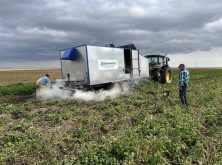Cereals are more than just a rotational crop between your canola and lentils; they can play a key role in setting up next year’s pulse crop for success by helping clean up your fields of weeds and soil-borne disease.
When you look at weed control and resistance management, cereal crops offer the broadest range of pre-seed and in-crop herbicide options for controlling grass and broadleaf weeds. You also have the improved ability to manage tough perennials and biennials, such as Canada thistle, white cockle, scentless chamomile and narrow-leaf hawksbeard.
Read Also

Claas brings 1000 Series SP forage harvesters to Canada
In mid-August, Claas unveiled its new line of Jaguar forage harvesters at an event in Visalia, California, deep in the heart of that state’s dairy region.
Pulse crops, on the other hand, don’t provide much opportunity for perennial weed control. And in many cases, the best result you can hope for is perennial weed suppression. That’s because you’re limited to small selection of Group 2 products as your main post-emergent control option.
However, we are seeing a growing incidence of Group 2-resistant weeds across Western Canada, which means we need to be tank mixing other products with our Group 2 actives. Even so, the selection of products and tank mix partners for pulse crops is very limited.
Kochia is a great example of how cereal crops can help combat weed pressure in next season’s pulse crop. Again, there aren’t many options for kochia control in pulses, and Group 2-resistant biotypes pretty much cover the Prairies. Since kochia has a fairly short seed bank, getting a few good years of weed control in your cereal crop can help lighten that kochia seed bank when you rotate into pulses. Keep in mind, however, that the tumbling nature of kochia seed dispersal means that neighbouring fields must also be kept clean to reduce the kochia seed bank.
Rotating from cereals to pulses can also help lower your seed and soil-borne disease pressure. Pests such as fusarium head blight or stripe rust are unique to cereal crops, while botrytis, sclerotinia and anthracnose will only prey on selected pulse and broadleaf crops.















